The venerable North Coast Limited–the oldest named train in the Northwest–became a domeliner in August, 1954. More than seven years after the Great Northern introduced the streamlined Empire Builder, the Northern Pacific finally caught up with, and in some ways surpassed, its Northwest rivals, including the Olympian Hiawatha. As was typical of the Northern Pacific, these improvements came incrementally.
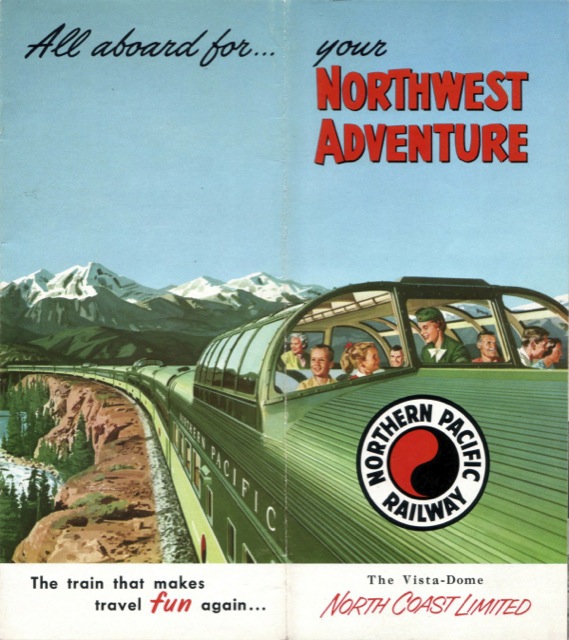 After 1954, much NP publicity prominently featured both the vista-dome cars and the stewardess-nurse on board every North Coast Limited. Click image to download a 20.7-MB PDF of this 20-page brochure about the train.
After 1954, much NP publicity prominently featured both the vista-dome cars and the stewardess-nurse on board every North Coast Limited. Click image to download a 20.7-MB PDF of this 20-page brochure about the train.
On November 16, 1952, the railway had finally speeded up its premiere train to 45-hour schedules comparable to its streamlined competition. At the same time, the Northern Pacific inaugurated the partly streamlined Mainstreeter as a secondary train, roughly comparable to the Western Star, on the 59-hour schedule of the old North Coast Limted.
It also hired Raymond Loewy to redesign the exterior of the train, which had been two-tone green with yellow pinstripes. Loewy’s two-tone green with white pinstripes doesn’t sound much different, but in fact the brighter greens were a tremendous improvement and produced one of the most beautiful streamlined trains in American history. Loewy later said he was inspired by evergreen trees near Butte, Montana, which came in shades of dark and light green. The first cars were painted in these colors in March, 1953.
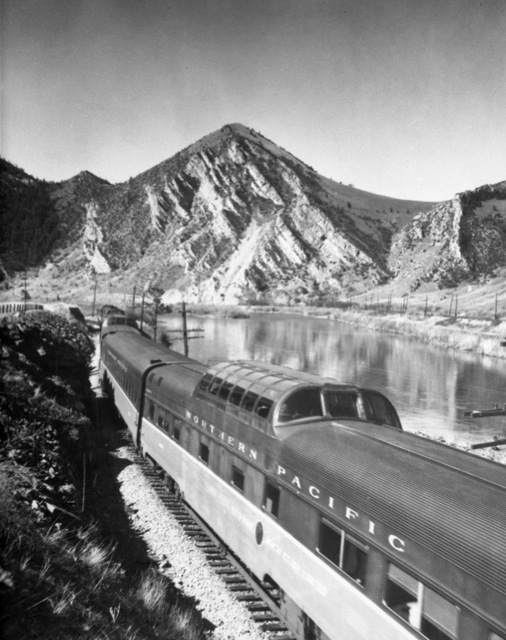 Northern Pacific telegrapher Ron Nixon took this photo of the vista-dome North Coast Limited near the spot where Raymond Loewy said he was inspired by evergreen trees to select the exterior colors for the train. Nixon took more than 30,000 photos in his life, mostly of trains, and many are archived at the Museum of the Rockies.
Northern Pacific telegrapher Ron Nixon took this photo of the vista-dome North Coast Limited near the spot where Raymond Loewy said he was inspired by evergreen trees to select the exterior colors for the train. Nixon took more than 30,000 photos in his life, mostly of trains, and many are archived at the Museum of the Rockies.
Loewy also helped design some of the train’s interiors. The first Loewy-designed diners entered service in September, 1953. The observation cars were also redecorated in 1954.
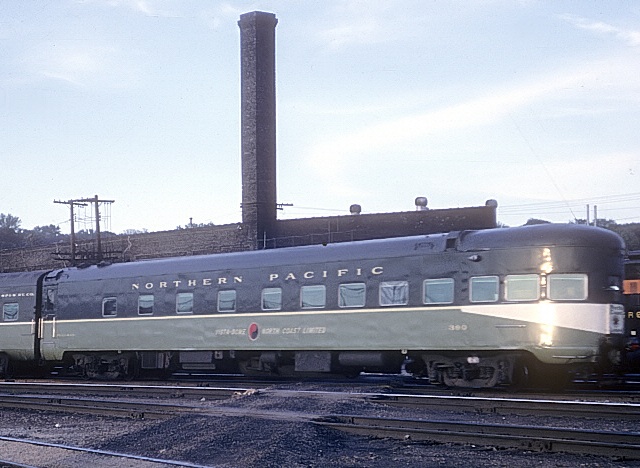
Raymond Loewy’s design for the observation cars had the white pinstripe flare out to be wide enough to embrace the train’s rear drumhead logo, matching a similar white flare on the locomotives. But, according to Bill Kuebler’s book on the North Coast Limited, after seeing car 390, the first observation car painted in that color scheme, NP officials apparently decided that the other cars should just have a pinstripe continue around the back of the car. Photo by and used with permission of Marty Bernard; click image to see entire photo.
Two Budd-built dome-coaches were added to each train starting on August 16, 1954. Each car cost about $244,000 ($2.0 million in today’s dollars) and weighed about 147,000 pounds, or nearly 30,000 more than a flat-topped coach. Although made of stainless steel, the domes were painted and lacked prominent flutes on the sides (though they had ribbed roofs, unlike the smooth tops of other NCL cars). The dome-coach floor plans were similar to those of the Twin Zephyrs and California Zephyr. Decorations included a painting of the Minnetonka, the NP’s first steam locomotive, on the bulkhead in front of the dome and a few smaller paintings elsewhere in the car.
Budd-built dome-sleepers were added in September. The dome-sleepers were roughly similar to the dome-sleepers on the B&O Capitol Limited, but had beds for 18 (instead of 16): four double bedrooms (sleeping 8) on the long end of the car; four roomettes on the short end, and, under the dome, four “duplex single rooms” that had sofas the full width of the room that turned into beds at night. Each of these cars cost $284,000 (about $2.4 million in today’s money) and weighed 155,000 pounds. By comparison, a flat-topped sleeper that the NP purchased in the same year cost $226,000 and weighed 134,000 pounds.
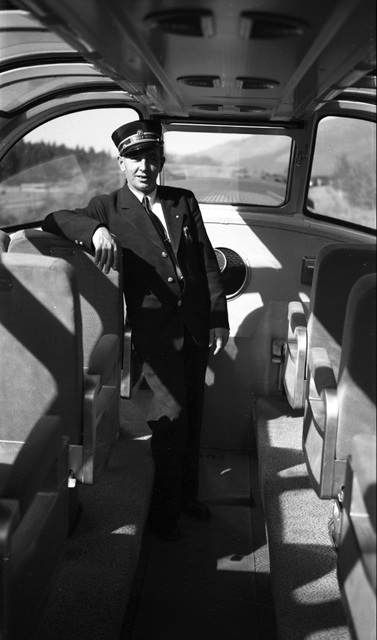 Conductor I.C. Adams stands in a dome during a shake-down cruise through Montana on July 27, 1954. The dome car is probably on the end of the Alaskan, Northern Pacific’s secondary train before it became the Mainstreeter, and appears to be closed to regular passengers. Note the NP logo at the front of the dome; this covers the loudspeaker grill for the train’s public address system. Ron Nixon photo.
Conductor I.C. Adams stands in a dome during a shake-down cruise through Montana on July 27, 1954. The dome car is probably on the end of the Alaskan, Northern Pacific’s secondary train before it became the Mainstreeter, and appears to be closed to regular passengers. Note the NP logo at the front of the dome; this covers the loudspeaker grill for the train’s public address system. Ron Nixon photo.
Although many people would agree that short domes offered better views than full-length domes, it still took three domes to exceed the number of dome seats on rival Milwaukee’s single Super Dome. The Northern Pacific probably chose to have four domes to be fair to Seattle and Portland passengers: the North Coast Limited split in Pasco, Washington, with part of the train going to Seattle and part to Portland. With four domes, passengers from each city could have a dome-coach and a dome-sleeper.
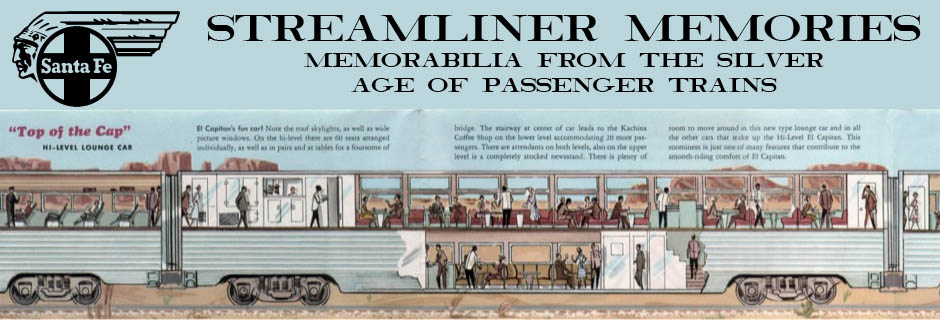
“Conductor I.C. Adams stands in a dome during a shake-down cruise through Montana on July 27, 1954. The dome car is probably on the end of the Alaskan, Northern Pacific’s secondary train before it became the Mainstreeter”
Not a chance this is the Alaskan because it was discontinued in November of 1952 when the Mainstreeter was created.
“At the same time, the Northern Pacific inaugurated the partly streamlined Mainstreeter as a secondary train, roughly comparable to the Western Star.”
This is 100 percent incorrect. The Western Star was a bona fide Streamliner, created using the equipment from the 1947 Empire Builder. The Mainstreeter continued using some heavyweight equipment to the end of the 1950s or later, and was never advertised as “streamliner.”
“Although many people would agree that short domes offered better views than full-length domes, it still took three domes to exceed the number of dome seats on rival Milwaukee’s single Super Dome.”
And many prefer full-length domes, which are norm on cruise trains in North America today. But only Great Northern’s Empire Builder offered short and full length domes, and boasted more dome seats than any other regularly-scheduled streamliner (150 per train).